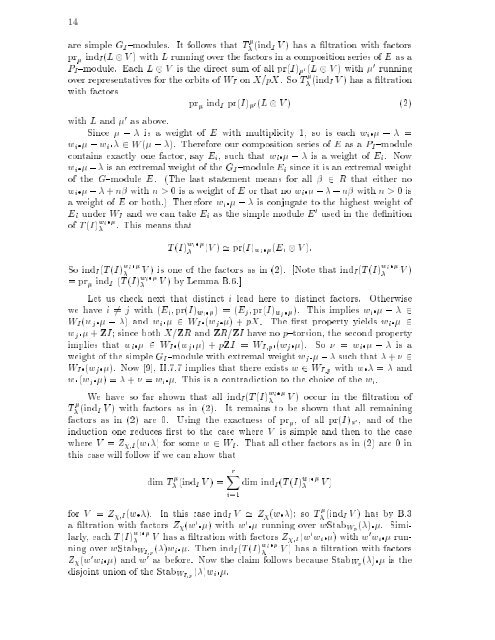subregular nilpotent representations of lie algebras in prime ...
subregular nilpotent representations of lie algebras in prime ...
subregular nilpotent representations of lie algebras in prime ...
You also want an ePaper? Increase the reach of your titles
YUMPU automatically turns print PDFs into web optimized ePapers that Google loves.
14<br />
are simple GI{modules. It follows that T (<strong>in</strong>dI V ) has a ltration with factors<br />
pr <strong>in</strong>dI(L V ) with L runn<strong>in</strong>g over the factors <strong>in</strong> a composition series <strong>of</strong> E as a<br />
PI{module. Each L V is the direct sum <strong>of</strong> all pr(I) 0(L V )with 0 runn<strong>in</strong>g<br />
over representatives for the orbits <strong>of</strong> WI on X=pX. SoT (<strong>in</strong>dI V ) has a ltration<br />
with factors<br />
pr <strong>in</strong>dI pr(I) 0(L V ) (2)<br />
with L and 0 as above.<br />
S<strong>in</strong>ce , is a weight <strong>of</strong>E with multiplicity 1, so is each wi , =<br />
wi , wi 2 W ( , ). Therefore our composition series <strong>of</strong> E as a PI{module<br />
conta<strong>in</strong>s exactly one factor, say Ei, such that wi , is a weight <strong>of</strong>Ei. Now<br />
wi , is an extremal weight <strong>of</strong> the GI{module Ei s<strong>in</strong>ce it is an extremal weight<br />
<strong>of</strong> the G{module E. (The last statement means for all 2 R that either no<br />
wi , + n with n>0isaweight <strong>of</strong>E or that no wi , , n with n>0is<br />
aweight <strong>of</strong>E or both.) Therefore wi , is conjugate to the highest weight <strong>of</strong><br />
Ei under WI and we can take Ei as the simple module E 0 used <strong>in</strong> the de nition<br />
<strong>of</strong> T (I) wi . This means that<br />
T (I) wi (V ) ' pr(I)wi (Ei V ):<br />
So <strong>in</strong>dI(T (I) wi V ) is one <strong>of</strong> the factors as <strong>in</strong> (2). [Note that <strong>in</strong>dI(T (I) wi V )<br />
=pr <strong>in</strong>dI (T (I) wi V )by Lemma B.6.]<br />
Let us check next that dist<strong>in</strong>ct i lead here to dist<strong>in</strong>ct factors. Otherwise<br />
we have i 6= j with (Ei; pr(I)wi )=(Ej; pr(I)wj ). This imp<strong>lie</strong>s wi , 2<br />
WI(wj , ) and wi 2 WI (wj )+pX. The rst property yields wi 2<br />
wj + ZI; s<strong>in</strong>ce both X=ZR and ZR=ZI have nop{torsion, the second property<br />
imp<strong>lie</strong>s that wi 2 WI (wj )+pZI = WI;p (wj ). So = wi , is a<br />
weight <strong>of</strong> the simple GI{module with extremal weight wj , such that + 2<br />
WI (wj ). Now [9], II.7.7 imp<strong>lie</strong>s that there exists w 2 WI;p with w = and<br />
w (wj )= + = wi . This is a contradiction to the choice <strong>of</strong> the wi.<br />
We have so far shown that all <strong>in</strong>dI(T (I) wi V ) occur <strong>in</strong> the ltration <strong>of</strong><br />
T (<strong>in</strong>dI V ) with factors as <strong>in</strong> (2). It rema<strong>in</strong>s to be shown that all rema<strong>in</strong><strong>in</strong>g<br />
factors as <strong>in</strong> (2) are 0. Us<strong>in</strong>g the exactness <strong>of</strong> pr , <strong>of</strong> all pr(I) 0, and <strong>of</strong> the<br />
<strong>in</strong>duction one reduces rst to the case where V is simple and then to the case<br />
where V = Z ;I(w ) for some w 2 WI. That all other factors as <strong>in</strong> (2) are 0 <strong>in</strong><br />
this case will follow ifwe can show that<br />
dim T (<strong>in</strong>dI V )=<br />
rX<br />
i=1<br />
dim <strong>in</strong>dI(T (I) wi V )<br />
for V = Z ;I(w ). In this case <strong>in</strong>dI V ' Z (w ); so T (<strong>in</strong>dI V ) has by B.3<br />
a ltration with factors Z (w 0 )withw 0 runn<strong>in</strong>g over wStabWp( ) . Similarly,<br />
each T (I) wi V has a ltration with factors Z ;I(w 0 wi )withw 0 wi runn<strong>in</strong>g<br />
over wStabWI;p( )wi .Then<strong>in</strong>dI(T (I) wi V ) has a ltration with factors<br />
Z (w 0 wi ) and w 0 as before. Now the claim follows because StabWp( ) is the<br />
disjo<strong>in</strong>t union <strong>of</strong> the StabWI;p( )wi .

















